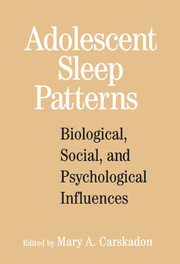Book contents
- Frontmatter
- Contents
- List of Contributors
- Foreword
- Preface
- Adolescent Sleep Patterns
- 1 Sleep and Adolescence: A Social Psychologist's Perspective
- 2 Factors Influencing Sleep Patterns of Adolescents
- 3 Endocrine Changes Associated with Puberty and Adolescence
- 4 Maturational Changes in Sleep-Wake Timing: Longitudinal Studies of the Circadian Activity Rhythm of a Diurnal Rodent
- 5 Nutrition and Circadian Activity Offset in Adolescent Rhesus Monkeys
- 6 Toward a Comparative Developmental Ecology of Human Sleep
- 7 Sleep Patterns of High School Students Living in São Paulo, Brazil
- 8 Sleep Patterns and Daytime Function in Adolescence: An Epidemiological Survey of an Italian High School Student Sample
- 9 Risks of Driving While Sleepy in Adolescents and Young Adults
- 10 What Can the Study of Work Scheduling Tell Us about Adolescent Sleep?
- 11 Accommodating the Sleep Patterns of Adolescents within Current Educational Structures: An Uncharted Path
- 12 Bridging the Gap between Research and Practice: What Will Adolescents' Sleep-Wake Patterns Look Like in the 21st Century?
- 13 Influence of Irregular Sleep Patterns on Waking Behavior
- 14 Stress and Sleep in Adolescence: A Clinical-Developmental Perspective
- 15 The Search for Vulnerability Signatures for Depression in High-Risk Adolescents: Mechanisms and Significance
- 16 The Regulation of Sleep-Arousal, Affect, and Attention in Adolescence: Some Questions and Speculations
- Index
Preface
Published online by Cambridge University Press: 22 September 2009
- Frontmatter
- Contents
- List of Contributors
- Foreword
- Preface
- Adolescent Sleep Patterns
- 1 Sleep and Adolescence: A Social Psychologist's Perspective
- 2 Factors Influencing Sleep Patterns of Adolescents
- 3 Endocrine Changes Associated with Puberty and Adolescence
- 4 Maturational Changes in Sleep-Wake Timing: Longitudinal Studies of the Circadian Activity Rhythm of a Diurnal Rodent
- 5 Nutrition and Circadian Activity Offset in Adolescent Rhesus Monkeys
- 6 Toward a Comparative Developmental Ecology of Human Sleep
- 7 Sleep Patterns of High School Students Living in São Paulo, Brazil
- 8 Sleep Patterns and Daytime Function in Adolescence: An Epidemiological Survey of an Italian High School Student Sample
- 9 Risks of Driving While Sleepy in Adolescents and Young Adults
- 10 What Can the Study of Work Scheduling Tell Us about Adolescent Sleep?
- 11 Accommodating the Sleep Patterns of Adolescents within Current Educational Structures: An Uncharted Path
- 12 Bridging the Gap between Research and Practice: What Will Adolescents' Sleep-Wake Patterns Look Like in the 21st Century?
- 13 Influence of Irregular Sleep Patterns on Waking Behavior
- 14 Stress and Sleep in Adolescence: A Clinical-Developmental Perspective
- 15 The Search for Vulnerability Signatures for Depression in High-Risk Adolescents: Mechanisms and Significance
- 16 The Regulation of Sleep-Arousal, Affect, and Attention in Adolescence: Some Questions and Speculations
- Index
Summary
The maturation of sleep patterns in teens has been a focus of my research for 25 years – long enough for the teens I first studied to have teenagers of their own. I often wonder why we don't know it all yet, and then I step into the world and am reminded of the complexity of life and the accelerating rate of change in opportunities, expectations, technology, and social mores. Developing humans are at the center of it all, with sleep's core behavioral role at the mercy of these factors and many more.
I am humbled by the task of attempting to understand the phenomena we observe, and I am inspired by the process of scientific investigation. As in other fields, progress is usually neither linear nor direct; it is affected by the evolution of methodologies and ideas, and the flow of knowledge can be entirely redirected by conceptual break-throughs. My research in the area of adolescent sleep patterns has benefited from several such major reconstructive conceptual shifts. The first seism occurred in the longitudinal Summer Sleep Camp study at Stanford – inspired by William Dement and Thomas Anders – in which we not only failed to confirm the predicted reduction of sleep need across adolescent development but also showed a restructuring of sleep so that pubertal adolescents sleeping no less than before were actually sleepier in the afternoon. The conclusion: teens don't need less sleep.
- Type
- Chapter
- Information
- Adolescent Sleep PatternsBiological, Social, and Psychological Influences, pp. xiii - xviiiPublisher: Cambridge University PressPrint publication year: 2002

